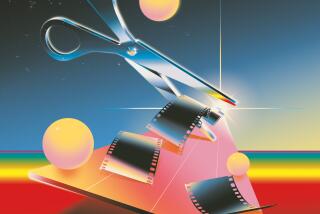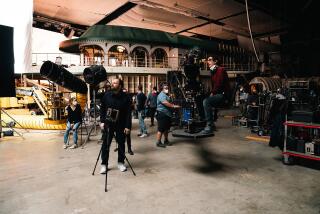Cinematographers find the magic in the mundane in films like ‘La La Land,’ ‘Moonlight’ and ‘Jackie’
From the beaches of Miami to the L.A. freeways, this year’s cinematography contenders find magic in the mundane. Here’s how they got the shots that make the whole world sing.
Linus Sandgren, ‘La La Land’
The scene: Emma Stone and Ryan Gosling go from mockery to a romantic pas de deux as they search for her car after a party in Griffith Park.
Shot significance: As the incipient lovebirds’ barbed banter gives way to outright flirtation, they slip from conversation into song and from searching for their cars to dancing with each other. The back-and-forth between mundane reality and musical fantasy mirrors the delicate negotiations that precede a first kiss and the way when it finally happens, the whole world shifts.
Birth of the shot: Drawing inspiration from the social-realist musicals of Jacques Demy (“The Umbrellas of Cherbourg”), director Damien Chazelle builds many of the film’s fantastical musical numbers around the mundane realities of Los Angeles life; the opening “Another Day of Sun” breaks out during a traffic jam on the 110. But for “A Lovely Night,” says Sandgren, they wanted to capture the magic-hour moment when the colors of the setting sun are “so heightened it seemed almost fake.”
Making it work: Stone and Gosling spent weeks learning the choreography in a cramped dance studio, with Sandgren and his team trying out camera angles with iPhones, and then moved rehearsal to the real outdoor location, where a slope in the road added another degree of difficulty. But that paled beside the decision to shoot the entire number in a single take, an elaborately choreographed crane shot in which the camera becomes a third partner in the dance. Sandgren and Chazelle agreed that they wanted to respect classical Hollywood techniques, which meant no digitally painting out shadows or light stands. By the time they’d put the whole thing together, the camera had to hit 27 different marks in one unbroken six-minute shot — which in turn had to be accomplished during the 15 minutes of the day when the light was just right.
“It was very hard to nail it,” Sandgren says. “Every time we rehearsed, there was something wrong with the take. But when we started shooting, everything came together. I find that’s always so interesting with doing these kinds of things. Nothing works until it works, and when it works, it’s magic.”
James Laxton, ‘Moonlight’
The scene: Chiron (Ashton Sanders), a gay Miami teenager, has his first sexual encounter on a darkened beach.
Shot significance: You never forget your first time, but in Chiron’s case, it’s especially fraught. In the housing projects of the 1980s, being openly gay is dangerous, and it’s not clear even Chiron knows where the evening is going until his friend Kevin leads the way. “It’s a private moment,” says Laxton, “shared with two people on a beach and no one around to judge.”
Birth of the shot: Although “Moonlight” was shot digitally, Laxton and director Barry Jenkins used lookup tables (a digital file that color codes an image) to emulate a different film stock for each of the movie’s three chapters: Fuji for the first, Kodak for the last, and Agfa for Chiron’s teenage years. “It has more of a pastel tendency,” Laxton explains. “The colors seem to mix in interesting ways that we just felt was appropriate for the story.” They also decided to shoot with a long, narrow anamorphic frame in order to enhance the movie’s cinematic qualities. “It places an importance on the images,” Laxton says, “and gives them value in a way that stories like this sometimes don’t get.”
Although the scene doesn’t require any elaborate camera moves, it proved to be the most difficult in the film. “Nighttime beaches pose a very physical challenge to cinema, generally speaking,” Laxton says. “One question we ask ourselves in any scene is ‘Where is the light coming from?’ When you’re doing a scene that takes place in complete darkness, that’s a difficult question to answer.”
Making it work: Without betraying the realism of the scene, Laxton created “a soft overhead pool” around the characters, which serves as an oasis in the middle of the darkened widescreen frame. It required careful adjustments to render the actors’ facial expressions visible while keeping the light confined to their little corner of the world, an oasis both isolated and protective. When the camera is facing the ocean, Laxton notes that you can’t see anything but a black expanse, but the lack of light on the waves only underlines the sense that, for this moment and for these two young men, nothing else exists. “It’s sort of an abyss behind them,” he says, “but I think we accept that as an audience. It doesn’t appear to be realistic on some level, but we’re so interested and engaged with this very personal moment that these characters are feeling.”
Stéphane Fontaine, ‘Jackie’
The scene: In a moment of quiet aboard Air Force One, Jackie Kennedy allows the shock of JFK’s assassination to sink in. As Lyndon Johnson takes the oath of office, the apparatus of government moves to restore normalcy, but Jackie resists the suggestion that she change into an outfit that’s not stained with her husband’s blood: “Let them see what they’ve done.”
Shot significance: “Jackie,” which was written by Noah Oppenheim and directed by Pablo Larraín, casts the first lady as the nation’s image-maker-in-chief, a woman whose understanding of visual power goes far beyond her status as a fashion icon. We’ve already seen her leading a camera crew through the White House for the first time, a tour that ends with a staged appearance by her husband that restores her to her place as the world’s most powerful housewife. But after his death, she becomes the guardian of his legacy, the creator of Camelot, and it all begins with that fateful moment.
Birth of the shot: For much of the shoot, “Jackie” took what cinematographer Fontaine calls “a cubist approach to storytelling.” Using 16 millimeter to emulate the feel of period footage — apart from the White House tour, which was shot with vintage video cameras — they filmed the same scenes in multiple locations and intercut the results, using wide-angle lenses and improvisation to give Natalie Portman freedom to move and react in character. “We wanted to stay close to her but not lose the background,” Fontaine explains. “Natalie would walk pretty much where she wanted to, stay far, come close. I’m not even sure she would know herself what she was about to do or say. It was like a ballet between her and the camera.”
On Air Force One, though, that freedom comes to an abrupt end. For this specific moment, Fontaine says, “nothing else could really matter.” After trying to hold the fragments of her husband’s shattered skull together as they sped down the Dallas freeway, Jackie is at her most helpless, and the scene’s distinct staging need to reflect that.
Making it work: Much of the film plays out in close-ups of Portman’s face, but on Air Force One, Fontaine chose to use a long lens for the only time on the shoot. Instead of being in documentary-style focus, the world around her becomes a blur. “It tells us and it tells Jackie as well that everything that we had before is gone forever, and from then on, she will be in a different world,” Fontaine explains. “The world she knew before is gone.”
Although the scene wasn’t shot on a real plane, Fontaine and Larraín chose to stick as close to reality as they could. “Although we were shooting in studio, we didn’t want to benefit from any of the advantages of being in a studio,” Fontaine says. They did, he admits, lengthen Air Force One by a few feet, but Portman was still physically confined by the size of the set and hemmed in by history. “I think every word was written. The dialogue was very precise.” Despite the strictures and the emotional intensity, he says, Portman kept things flowing smoothly. “She has this amazing quality of staying focused and being at the same time totally easygoing during takes, very laid back,” he says. “It should be more common among actors, I think.”
See the most read stories this hour »
ALSO:
The heart of a film often comes down to one key scene
Why a change is gonna come in Oscar races for director and cinematography
‘’Moonlight’ changed me,’ says director Barry Jenkins of his emotional story of acceptance
More to Read
From the Oscars to the Emmys.
Get the Envelope newsletter for exclusive awards season coverage, behind-the-scenes stories from the Envelope podcast and columnist Glenn Whipp’s must-read analysis.
You may occasionally receive promotional content from the Los Angeles Times.






